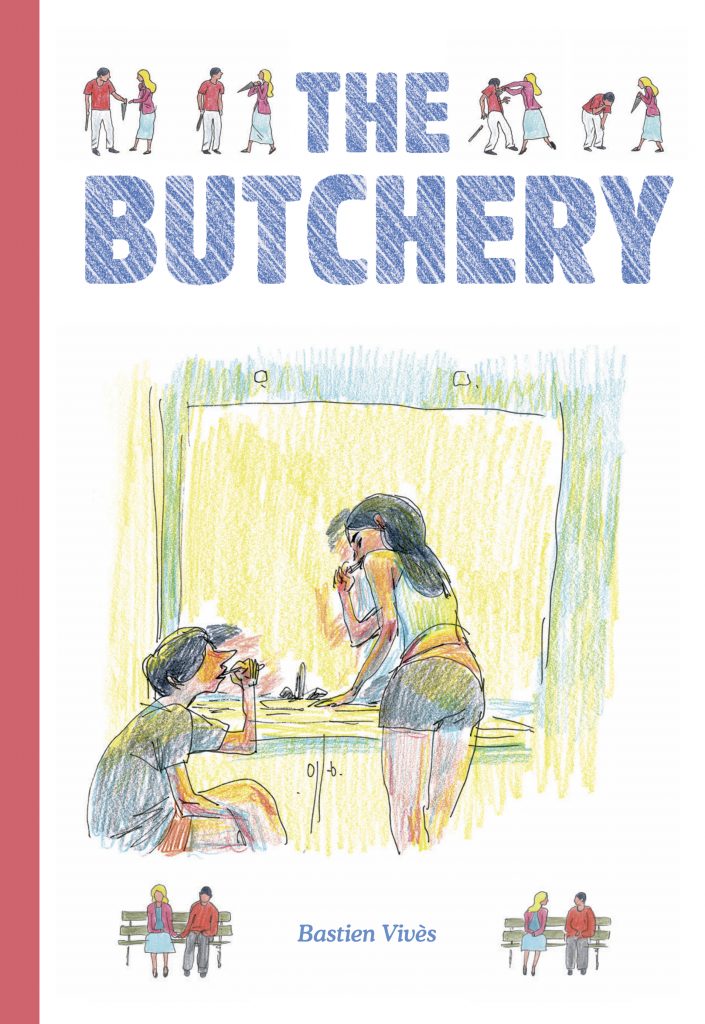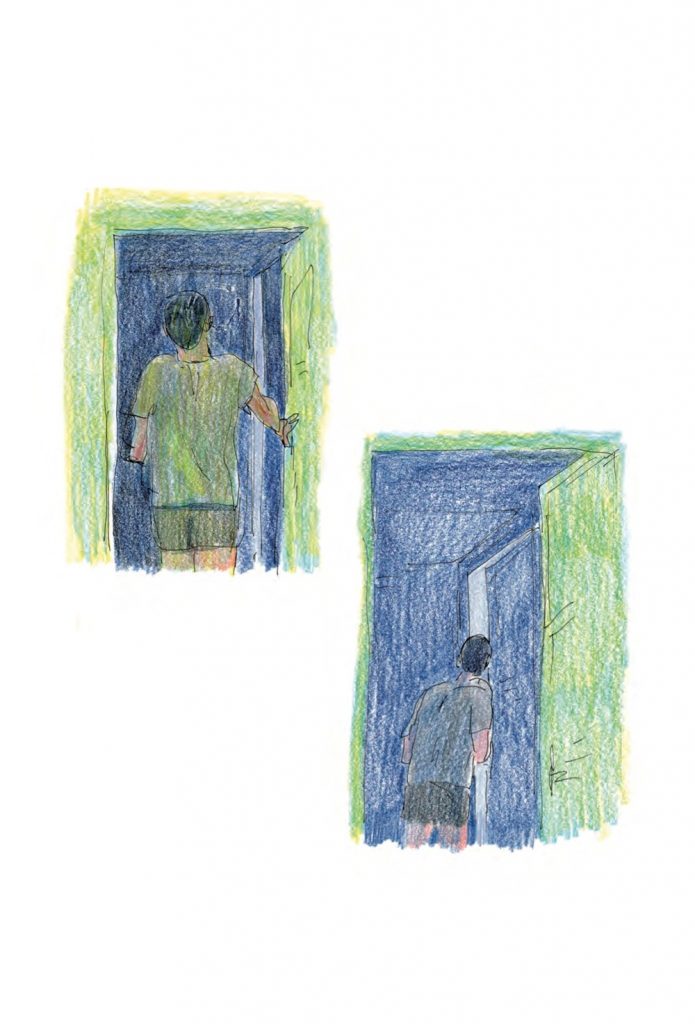
The French cartoonist Bastien Vivès is best known in the United States for his work on The Last Man, an action comic series published by First Second. A prolific cartoonist, Vivès’ work has recently been picked up by Fantagraphics through their release of The Grande Odalisque earlier this year. The Butchery is one of his first solo projects published in the US market, and the 92-page hardcover is a contrast to his more mainstream work. The Last Man is a straightforward sci-fi adventure narrative (at least, the few volumes of it that I’ve read), and that series is far more literal and direct than anything found in the symbolic storytelling of The Butchery.
The book starts with a vignette, a story of the parting of two lovers. There’s a lot that isn’t said (what they are doing, what the night was like, even who they are), but the moment is crystalized in a flash when an unnamed man stands at the door to his apartment, only to have his departed lover return for another kiss before leaving. This sweet scene between the unnamed main characters is immediately juxtaposed with men getting ready to parachute out of a military plane. The jump will be fine, a senior soldier tells a 17-year old first-timer, but warns him about what happens when he’s out of the plane, saying “Watch your back, though. You could get butchered down there.” The juxtaposition of these two scenes makes the message clear: falling in love is easy, but the danger lies in what comes after.

The energy and flow of The Butchery passes between delicate scenes like a living room waltz lesson and more allegorical moments where characters hurt each other, sometimes with words, and sometimes by swinging butcher knives and bats at each other. Vivès depicts the tension of the relationship between the two lovers in The Butchery through these scenes, and Vivès chooses particular styles to match the mood. The passionate, romantic occasions are often soft and sketchy, like a blurred photo or a memory that is beginning to fade; Vivès depicts the hurt between the two people with a more defined mark-making, yet more abstracted style, almost in miniature, faceless, nameless, and discrete. The romantic scenes are beautiful, and Vivès’ control of colored pencil, figure, and light are noteworthy in a book that uses negative space liberally to control the flow and mood of the page. A specific scene where Vivès draws the two lovers looking at each other, getting ready for bed, feels both well-observed and beautifully rendered, despite its muddy quality.
Vivès is asking readers to intuit a lot of what happens in the lovers’ relationship between these alternating sets of stories, but the introduction tells us everything we need to know — the rush of adrenaline that comes with jumping out of a plane is exciting and invigorating, like new love, but eventually, you’re going to hit the ground. The two lovers, entangled in a waltz, move nearer to and further from each other in their individual stories, but, in the end, there’s only one way a book about romance titled The Butchery can go.

You could call The Butchery a bittersweet tale, though it’s more bitter than sweet, and Vivès seems to indicate that all romance is bound up in the lines of battle. It is a butchery, after all, and if you survive the first jump, you’re going to have to jump again. The Butchery is so focused on the pain of disconnection that any pleasure from romantic love and relationship seems fleeting and mercurial. Even when you have it all, even in the bliss of love, Vivès’ focus is on what comes next. There’s an inherent cynicism to this view, but Vivès seems sure of it: any pleasure that connects people is inextricably bound to pain and suffering.
Of course, this is not the first comic about the tempestuous nature of romance or of the bitterness of love lost, nor will it be the last. But Vivès has a way of capturing the interstitial moments, things that seem insignificant but are actually the hinges upon which the entire relationship between these two people swing. The way in which he does this is remarkable, and I find myself returning to this work, impressed with his figure drawing, pacing, and use of color. By including his readers in these moments, he exposes them to the full breadth and depth of the beauty and despair of his characters’ failed relationship, making The Butchery paradoxically compressed and expansive. Like love or sadness, this intimate work by Vivès contains multitudes.

SOLRAD is made possible by the generous donations of readers like you. Support our Patreon campaign, or make a tax-deductible donation to our publisher, Fieldmouse Press, today.

Leave a Reply